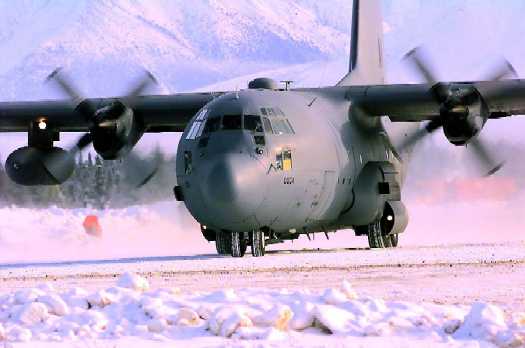

The C-130 Hercules primarily performs the tactical portion of the airlift mission. The aircraft is capable of operating from rough, dirt strips and is the prime transport for airdropping troops and equipment into hostile areas. C-130s operate throughout the U.S. Air Force, serving with Air Mobility Command (stateside based), theater commands, Air National Guard and the Air Force Reserve Command, fulfilling a wide range of operational missions in both peace and war situations. Basic and specialized versions of the aircraft airframe perform a diverse number of roles, including airlift support, Arctic ice resupply, aeromedical missions, aerial spray missions, fire-fighting duties for the U.S. Forest Service and natural disaster relief missions.
In its personnel carrier role, the C-130 can accommodate 92 combat troops or 64 fully-equipped paratroops on side-facing seats. For medical evacuations, it carries 74 litter patients and two medical attendants. Paratroopers exit the aircraft through two doors on either side of the aircraft behind the landing-gear fairings. Another exit is off the rear ramp for airdrops.
The C-130 Hercules joins on mercy flights throughout the world, bringing in food, clothing, shelter, doctors, nurses and medical supplies and moving victims to safety. C-130 Hercules have served other nations, airlifting heavy equipment into remote areas to build airports and roads, search for oil and transport local goods.
The C-130J is the latest addition to the C-130 fleet and will eventually begin to replace retiring C-130E's and C-130H's. The C-130J incorporates state-of-the-art technology to reduce manpower requirements, lower operating and support costs, and provide life cycle cost savings over earlier C-130 models. Compared to older C-130s, the C-130J climbs faster and higher, flies farther at a higher cruise speed, and takes off and lands in a shorter distance. Currently there are six aircraft in the test program.
Major improvements include:
Four decades have elapsed since the Air Force issued its original design specification, yet the C-130 remains in production. The initial production model was the C-130A, with four Allison T56-A-11 or -9 turboprops. A total of 219 were ordered and deliveries began in December 1956. Two DC-130A's (originally GC-130A's) were built as drone launchers/directors, carrying up to four drones on underwing pylons. All special equipment was removable, permitting the aircraft to be used as freighters, assault transports or ambulances.
The C-130B introduced Allison T56-A-7 turboprops and the first of 134 entered Air Force service in April 1959. C-130B's were used in aerial fire fighting missions by Air National Guard and Air Force Reserve units. Six C-130B's were modified in 1961 for snatch recovery of classified U.S. Air Force satellites by the 6593rd Test Squadron at Hickam Air Force Base, Hawaii.
As a partial response to the overwhelming role played by the tactical airlift fleet in Operation Just Cause and in the Persian Gulf War, Congress approved the procurement of more C-130H's to replace aging E models.
Primary Function: Tactical and intratheater airlift
Contractor: Lockheed Martin Aeronautical Systems Company
Power Plant: Four Allison T56-A-15 turboprops; 4,300 horsepower, each engine
Length: 97 feet, 9 inches (29.3 meters)
Height: 38 feet, 3 inches (11.4 meters)
Wingspan: 132 feet, 7 inches (39.7 meters)
Cargo Compartment: Length, 41 feet (12.5 meters); width, 108 inches (2.74 meters); height, 9 feet (2.74 meters). Rear ramp (one pallet position); length, 88 inches (2.23 meters); width, 108 inches (2.74 meters); height, 76 inches (1.93 meters)
Speed: 374 mph (Mach 0.57) at 20,000 feet (6,060 meters)
Ceiling: 33,000 feet (10,000 meters) with 45,000 pounds (17,716 kilograms) payload
Maximum Takeoff Weight: 155,000 pounds (69,750 kilograms)
Range: 2,356 miles (2,049 nautical miles) with maximum payload; 2,500 miles (2,174 nautical miles) with 25,000 pounds (11,250 kilograms) cargo; 5,200 miles (4,522 nautical miles) with no cargo
Crew: Five (two pilots, a navigator, flight engineer and loadmaster); up to 92 troops or 64 paratroops or 74 litter patients or six standard freight pallets with a maximum of 45,000 pounds of cargo.
Unit Cost: $14.1 million (1996 dollars)
Date Deployed: April 1955
Inventory: Active force, 93; Air Reserve component (Reserve and ANG), 296
Air Mobility Command, Public Affairs Office; 503 J Street, Suite 214; Scott AFB, IL 62225-5335, DSN 576-5003 or (618) 256-5003.
Current as of June 1999
keywords: aircraft, airlift